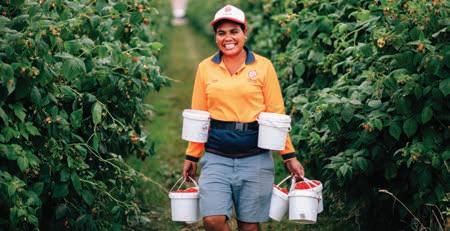
7 minute read
Workforce issues: an update
Rachel Mackenzie, Executive Director, Berries Australia
There is no doubt that the berry industry is facing a workforce crisis because of the closure of international borders. As a sector we have long been dependent on working holiday makers (WHMs) to fill our seasonal workforce needs and those workers are leaving the country and not being replaced.
Advertisement
The numbers are stark. According to government data, as of December 2019 there were 141,142 Working Holiday Makers in the country compared with 49,542 WHM's left by December 2020. These workers are said to be leaving the country at a rate of 1,000 per week. In addition, there are around 6,500 Pacific seasonal workers in the country compared with 14,000 in 2019.
Even with an almost 10-fold increase in the number of locals taking up seasonal jobs, we are still looking at a significant shortfall. Part of our issue is that as an industry we have always struggled with getting exact numbers in relation to our workforce needs but it doesn’t take a maths whizz to see that there will not be enough workers. Rough estimates looking at Queensland and NSW indicate that the berry industry alone will need around 14,000 workers in quarter 2 (Apr-Jun), 27,000 in quarter 3 and 24,000 in quarter 4. It is unrealistic to think that more than half of the backpackers left in Australia will work in this sector!
Berries Australia along with other industry associations has been lobbying all levels of government since March last year for action on this issue and it is deeply disappointing that so little has been put on the table. Our first hurdle is always that most politicians can’t see past the local unemployed as a solution. But despite incentive schemes and fancy websites, there are a range of structural barriers to many locals taking up work that is seasonal and regional in nature. Workforce participation by Australians has increased but it is a drop in the ocean compared to what we actually need. The only viable solution on the table is to increase the number of Pacific Island workers in Australia. The Australian government has provided up to 22,000 visas but have also washed their hands of any responsibility for quarantine which means that industry groups and growers have to navigate through an ever-changing landscape of options and negotiate separately with each State government. Unfortunately, this has meant growers in some states have significantly more and cheaper options than others. Overlaid on this is the critical accommodation shortage in some berry growing regions.
What can the individual grower do?
• Plan for the worst and don’t just take the word of your labour hire company that they will be able to meet your requirements.
• Expect to pay more for workers and bear in mind that you need to be the best employer you can be.
• Write to your local state and federal politicians and make sure they understand what this situation means for your business.
• Find out about the Seasonal Worker Program (SWP) and Pacific Labour Scheme (PLS) to see if either of these schemes may be able to assist you.
• If you do lose any crops, fill in the National Lost Crop Register (bit.ly/BA-NLCR) and if you are willing to talk to the media, let Berries Australia know.
The Pacific option – what do I need to know?
With the dwindling number of backpackers, the increased use of Pacific workers seems to be the only viable solution on the table to solve the workforce crisis. That said, accessing these workers is expensive and far more complicated than employing a traditional backpacker. This article aims to give a basic summary of the programs for those who have not used them before. There are two programs that facilitate pacific workers in Australia and both issue workers with 403 visas. It is important to understand that these programs are part of Australia’s AID program to the Pacific and not just schemes to provide workers.
All participating workers have the same rights and protections as Australian workers. There is speculation that the two programs will soon be administered by the same department which will be a good thing. Both programs require potential employers to become an Approved Employers (AEs) prior to being able to recruit workers. AEs must be able to guarantee work for the worker and provide accommodation that meets certain standards as well as pastoral care for these workers. Both growers and labour hire companies can become Approved Employers. Becoming an approved employer is a time-consuming process and for many growers the best way to access these workers is through a labour hire company that is an existing AE. You can view the list of current AE at any time at bit. ly/SWP-AE. Please also be aware that competition for these workers is fierce.
Each State has a different approach to quarantining these workers and who pays. In NSW, AE are expected to pay $3000/ worker whereas the Tasmanian government has fully subsidised the quarantine costs. At the time of writing, Queensland was using an on-farm quarantine model but was looking into large quarantine facilities in regional areas. The Berries Australia website bit.ly/BA-Manage-Workers will provide the most up-to-date information and links as the landscape is changing very quickly.
Important information on Visas
As a consequence of COVID-19, the Australian government has created a new subclass of visa called the Temporary Activity visa (subclass 408) also known as the Pandemic Visa.
With this visa you can remain in Australia if you have no other visa options and are unable to depart Australia due to COVID-19 travel restrictions or remain in Australia to work in critical sectors including agriculture during the COVID-19 pandemic.
Under the 408 visa the visa holder is bound by the conditions of the original visa they came in on. That means that Pacific workers who entered under a 403 visa must remain with their Approved Employer unless given specific permission to move to another Approved Employer.
Some workers who entered on a 403 visa are “claiming asylum” and applying for protection visas (Protection visa (subclass 866)). Any worker who is still on a valid 403 or 408 visa is legally bound by the conditions of that visa until that visa expires.
www.homeaffairs.gov.au/help-and-support/ departmental-forms/online-forms/border-watch

SWP staff at Hillwood berries in Tasmania.
Photo credit: Hillwood Berries.
The Department of Home Affairs is cracking down on these arrangements. It is important for the workers to understand that approximately 90% of the applications for a Protection visa (subclass 866) are rejected and that following that rejection, they will not be allowed back into Australia again – under any circumstances.
Working holiday makers
Working holiday makers are able to extend their existing 417 or 462 visas for a third year provided they meet certain conditions. They remain subject to all of the existing visa requirements.
Student Visas
Students employed in the agriculture sector can work more than 40 hours/fortnight. The website is currently silent on the maximum number of hours they can work in the agriculture sector. immi.homeaffairs.gov.au/ work-in-australia/Pages/working-in-agriculture/ agricultural-employers.aspx
How do you check someone's visa details with VEVO?
Only registered organisations that have a visa holder's permission can check visa details. The organisation must register for an ImmiAccount. You can then access VEVO through your ImmiAccount. You can only check the visa conditions of nonAustralian passport holders. You cannot check Australian passports in VEVO. immi.homeaffairs.gov.au/visas/already-have-a-visa/ check-visa-details-and-conditions/check-conditionsonline/for-organisations
Making peace with piece rates
Piece rates are a very important productivity tool for the horticulture sector. They enable growers to reward those who are the most productive which is particularly important when there is high competition for workers. The guidelines are absolutely clear on how to calculate the piece rate. Please refer to the Fair Work Ombudsman website if you would like any further clarification. www.fairwork.gov.au/pay/minimum-wages/ piece-rates-and-commission-payments
The Horticulture Award sets out how piecework is to be calculated and includes a piecework loading of 15% which applies to both permanent and casual wages.
There is also a template piecework agreement, which every employee undertaking piecework must sign. The piecework agreement must contain the unit rate (ie pick or pack rate) up front, provide for the piecework loading to be paid (15%), and, if applicable the casual loading (25%).
The formulation of the piecework rate is done as follows – for example, here using level 1 rate from the Horticulture Award:
LEVEL 1 BASE HOURLY RATE $19.84
PIECEWORK LOADING 15% $2.98
CASUAL LOADING 25% $4.96
HOURLY RATE FOR AVERAGE COMPETENT WORKER: $27.78 PER HOUR
If the average competent worker picks 10 buckets in an hour, they are paid $2.78 per bucket and this is the set unit rate – the number of units x unit rate = hourly rate paid. The unit rate can vary to take account of particular harvest conditions – e.g. a higher rate if picking is slower due to weather, or less product is available – e.g. at the beginning or end of the season. The Agreement provides for the Employer to state the conditions that apply to the different rates.
If you are in any doubt, then visit the FWO Horticulture Showcase at https://www.fairwork.gov.au/horticulture-showcase


